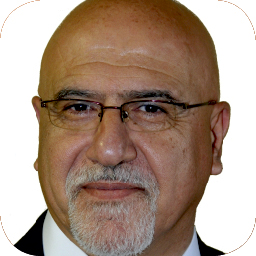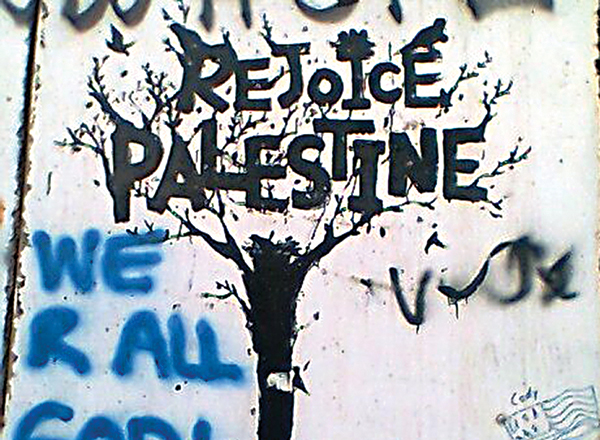
When we created the Kairos Document (launched in December 2009), we at Kairos Palestine tried to reflect on what tourism and pilgrimage really mean to us. In our advocacy, we try to see and respond to both our reality and our rights. We address churches, tourists, and pilgrims of all faiths and ethnicities in hopes they will see the injustice happening in Palestine and walk and work in solidarity with us along the path to justice. Kairos Palestine believes in facilitating the “sight” of the many people who visit our land, whether they are tourists or pilgrims.
To be a tourist is to play an unusual role.
You arrive in a place you’ve never seen before and stay for some time. You explore. Perhaps you read a book that tells you where to go, or recruit a guide to take you there. You take pictures, you look and look, and what you see will be the only material you can use to make sense of where you are. Perhaps you realize that the information offered to you is, in itself, a purposeful narrative that will demand your acceptance and affirmation, often at the exclusion of other narratives.
Because of this, tourism is a heavily political business anywhere you go, whether or not the politics are advertised. This is especially true when it comes to tourism in places of conflict, and it raises many crucial questions: How do you know you’re not contributing to a situation of injustice? What are your responsibilities?
Martha Honey, co-director of the Centre for Responsible Tourism, writes in her article, “Tourism: Preventing Conflict, Promoting Peace,” that “It is responsible tourism, not simply conventional or mass tourism that holds the potential to prevent conflict and promote peace.” (The italics are hers.) Honey also stresses that “tourism developments that come in from the outside without respecting and working with the local communities can exacerbate existing tensions and conflicts; they can also give rise to new injustices, inequities, and conflicts.”
♦ Addressing the Palestinian-Israel conflict is crucial, given its ramifications for global peace. The Holy Land attracts pilgrims from around the world who join tours that are strongly promoted by the Israeli government. But this type of tourism is of little benefit to Palestinians.
There are several different forms that tourism takes in Palestine: tourism organized directly by Israel; tourism organized by other countries with Israel’s coordination and approval, including religious pilgrimages; “political thrill” tourism; and Birthright Israel programs, which are free trips Israel that Israel offers to any Jew in the world as a birthright and which many participants report are used to brainwash them. Each of these forms reveals the political agendas that are at work in the tourism industry and at work in shaping the Palestinian/Israeli conflict itself.
Most countries use tourism to market themselves. But, in the case of Israel, its strategy is also to demonize the Palestinians, vilifying their narrative and stripping them of their places, resources, and rights. During the past few decades, Israel has actively prevented Palestinians from taking the initiative in their own tourism industry. Since Israel controls all of Palestine’s borders and regulates all movement inside those borders, impeding Palestinian-led tourism is just another tactic employed by a comprehensive occupation.
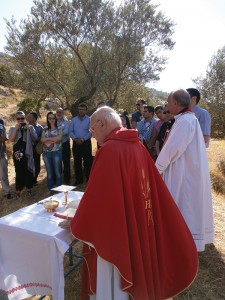
Most tourists (including pilgrims) are received in Israel by Israeli tour guides, accommodated in Israeli hotels, and fed Israeli stories and Zionist interpretations of the Old Testament. While visiting the Church of the Nativity in Bethlehem, an Israeli tour guide may offer a quip about Arab backwardness, or a warning about Arabs’ exploitative nature. The tourists may be discouraged from wandering beyond the immediate vicinity of the tourist site and from patronizing Palestinian businesses. They are then ushered back onto their buses and sped through the checkpoint back to Jerusalem.
The fact that few Palestinians are permitted to cross the checkpoint at all is a reality that the tourists may never be told. The distortion and repression that are part of these strategies are not only present in tourist initiatives led directly by Israel, but also in those funded and organized by other countries. And this applies to pilgrims also, as pilgrimages have been successfully monopolized by the Israeli tourism industry and its accompanying political agenda, which begins with coordinated Israeli propaganda before the pilgrimage even starts.
The consequence of such tourism in Palestine is the promotion of a historical narrative that excludes Palestinians, causes economic damage, erodes solidarity, and cultivates prejudice. As the Ecumenical Coalition on Tourism (ECOT) writes, “Tourism promotes the wrong assumption that people have the ability to gain fulfillment through interaction with objects, like nature, beaches, or objectified humans, and that a subject gains subject-hood by relating with an object. In the absence of a subject-to-subject relationship, people are deprived of their human dignity. Interaction with objectified people or nature leads to the erosion of people-ness. All forms of objectification are anathema to God in whose image we are created.” To extend these thoughts to the Palestinian context, the dominant tourism industry in Palestine/Israel not only perpetuates injustice, but is actually built upon it.
In recent years, Palestinians have been trying to counter the unjust restrictions imposed upon them by the tourism industry and to put themselves on the map. Alternative and authentic tourism groups have flourished in Palestine as a way to secure a new kind of tourism, which tells our stories and speaks our truth. Predictably, Israel recognizes the power of these alternative tours and has continuously placed obstacles in their path. But Palestinian tourism has already gained great momentum, and its participants are determined to keep building networks, resources, and communities of supporters.
One such initiative was embedded in the Kairos document, “Come and See,” which included a call sent out to international churches, the principal coordinators of pilgrimages. The document was based on the concept of Justice Tourism, which is ethical in formulation, spiritual in orientation, and places human dignity at the core of any tourism project. This document seeks to promote a paradigm by means of which tourism becomes a quest for spirituality through encounters with other people, and a quest in search of God’s truth. Within this paradigm, a traveler can make the choice to seek people-to-people encounters, a path that leads to mutuality, solidarity, and the real discovery of human community.
Kairos emphasizes the power of “Seeing” because we believe that for many people of goodwill who come to visit Israel and Palestine, a clear vision of the reality around them is enough for them to be transformed. The “Come and See” call was born of our belief in the significance of tourism as an economic, political, and spiritual force that can effectively and truthfully advocate for the Palestinian struggle and for peace with justice through Palestinian-organized tours.
We seek truthfulness, meaning truthful communication of our reality and truthful connections with those who visit us, not melodrama or pity. Our aim is to introduce Palestine in all its cultural, historical, and religious richness, unaltered by Zionist influence, to international tourists. This experience, also known as a Kairos Pilgrimage, will speak for itself, leading to more enlightened attitudes toward Palestinians, our reality, and our work for a just peace.
When do we need Kairos pilgrimages?
- When “Seeing” becomes easier for tourists than for the indigenous people.
Palestinians are not free to travel in their own home. Many sights and many forms of seeing are denied to them. The illegal Israeli Occupation controls the daily lives of Palestinians through roadblocks, checkpoints, draconian permit systems, and other restrictions. Due to the enclosure of Jerusalem, most Palestinians (both Christians and Muslims) are unable to access their religious and tourism sites.
Tourism, in addition to being a cultural enterprise, is also an economic one. For Palestinians, this adds insult to injury because Israel prevents Palestinians from accessing their own lands, holy sites, and stories, and also prevents their access to the income generated by tourism.
♦ Over time, Palestine’s historical, cultural, and religious heritage has been exploited to serve Israel’s political and commercial interests at the expense of Palestinian identity, dignity, and economic autonomy. Not only do most tourists remain ignorant of Palestine’s cultural richness, but they also tend to be provided with a distorted image of both the Israeli state and Palestinian society.
- When “Seeing” is perceived as a threat to national security.
Many people around the world have already seen the truth of the Israeli Occupation and engage in public nonviolent actions to protest what they have seen. Israel, of course, tries to stop them. Among the many examples are the Gaza-bound Freedom Flotilla, the “Welcome to Palestine” campaign, and the conference, “Christ at the Checkpoint.” Israeli opposition to these events only sharpens our focus.
- When the state monopolizes the “Seeing” industry, and turns it into a tool to justify its own oppression and brutality.
Israel’s manipulation of tourism in order to whitewash its image before the international community is evident.
- When tourists come to what they believe is the Holy Land, while, in reality they are visiting a land without holiness, where God’s creation is humiliated daily.
Such a country can’t be legitimately called a holy land. Maintaining this illusion, by either the people leading tours or the people who participate in them, does not bring hope to this land, as many visitors think it does. On the contrary, it removes hope and dignity.
- When the oppressed indigenous people adopt the narrative of the oppressor because they fear losing their jobs.
Some Palestinian tour guides have come to call the West Bank “Judea and Samaria,” and refer to it as “disputed land.” This is the result of fear of being reprimanded or fired.
When can we call a pilgrimage a Kairos pilgrimage?
- When “Seeing” becomes a necessary step on the journey of a spiritual pilgrim.
The hajj is not a journey undertaken for comfort. It is undertaken out of concern for a person’s spiritual, emotional, intellectual, and social wellbeing. It is an expression of commitment to the other.
- When “Seeing” is a deliberate step, not an accidental one.
“Looking” means you are simply in a certain place at a certain time. “Seeing” means you actively involve yourself with what surrounds you.
- When “Seeing” becomes an act of repentance for the sins of silence and ignorance.
Human beings are implicated both in the actions and omissions of their community. “Seeing” may be an individual gesture, but it can only occur by assuming collective responsibility. If we have looked away from injustice before, we must repent for having looked away, and we must then look farther inward.
- When “Seeing” becomes an experience of living and walking with the oppressed, not just talking about them.
In the past, pilgrimages took many years to cover the same distance we can now cover in days. Then, the distance was part of the pilgrimage. Today, given the speed of technology and transportation, we must find new ways to grasp the obligations of pilgrimage. Although we may not travel by foot or animal today, the “spiritual distance” of the journey should stay intact with the pilgrim taking time to reflect and meditate.
- When “Seeing” becomes a true journey to solidarity.
One starts from bias and travels to a change of belief, skepticism, committed engagement, and true solidarity.
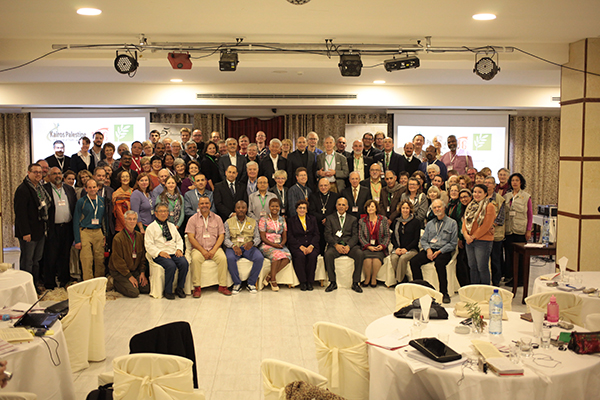
What precautions must be taken during a Kairos pilgrimage?
- “Seeing” should not become an alternative to action.
It is a beginning, not a conclusion. So “Seeing” must not replace action.
- “Seeing” does not take the form of normalization with the occupier.
Tourism in Palestine should not be an act of normalization with the Occupation. The situation on the ground is not normal, and Israel is not a country that respects freedom of worship. Israel interprets religious tourism as recognition of their “democracy,” but Israel is a country that systematically denies Palestinians the right to visit their holy sites and pray there.
- The oppressed do not look at “Seeing” as simply an industry they need to compete with, but as solidarity and action.
“Seeing” involves sharing a vision with someone, who, in turn, reciprocates. It is not only the visitors who must “see” the oppressed, but the oppressed must “see” the visitors too. Only then can solidarity take root.
- “Seeing” should not become restricted to the rich and those able to secure a visa.
The matter at hand is beyond tourism. What we’re calling for is a fundamental act of advocacy and solidarity that leads to broader practice. This is the great challenge we’re faced with today.
When do we know the Kairos pilgrimage has been successful?
- When it becomes an act of conscious struggle and an act of serious solidarity.
This must occur despite all the propaganda against Palestinians and against visiting Palestine.
- When it becomes a platform for continuous education.
This platform should be accompanied by educational materials that are easy to use and understand.
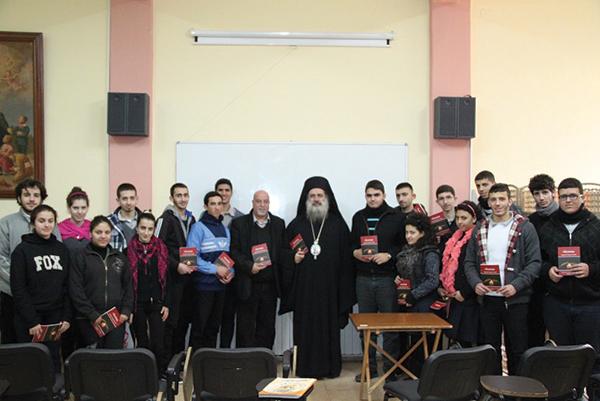
- When the Palestinian tourism industry realizes that dignity comes first and financial benefits come second.
Palestinians must refuse to let others objectify them and we must also refuse to objectify ourselves.
- When all of us, both pilgrims and Palestinians, are transformed.
We all must establish the humane in the midst of the inhumane, the just in the midst of the unjust, participation in the midst of domination, and deliverance in the midst of captivity. We must understand how our faith in God opens up the possibilities of human freedom, and points to a better human society for which we must work.
To experience the possibilities of human freedom – together – is indeed to be transformed. I echo the words of Kenneth Cragg, an American Methodist, who, on a visit to my town of Beit Sahour, eloquently said, “We should all feel an urgency to know the Arab Christian, lest the aura of the Holy Land lead us to think of a spiritual museum rather than of living, dying people in the throes of a deep struggle for survival and fulfillment.”
We are, indeed, very much alive.
» Throughout his career, Rifat Odeh Kassis has been advocating for the effective application of international human rights and humanitarian law in Palestine through various professional and voluntary positions. He was the driving force and one of the co-authors of Kairos Palestine document and has been the general coordinator of the Kairos Palestine Movement since its inception. He has published two books: Palestine, A Bleeding Wound in the World’s Conscience and Kairos for Palestine.

